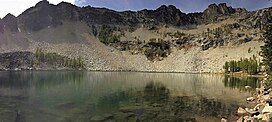
Hinkhouse Peak is a 7,566-foot-elevation (2,306-meter) mountain summit located on the shared border of Okanogan County and Chelan County in Washington state. It is part of the Okanogan Range which is a sub-range of the North Cascades Range. Hinkhouse Peak is situated on land administered by the Okanogan–Wenatchee National Forest. The nearest higher neighbor is Liberty Bell Mountain, 1.52 miles (2.45 km) to the south. Hinkhouse Peak is situated north of Washington Pass, at the east end of a high ridge which connects to Cutthroat Peak. A high ridge extending northeast connects it to Constitution Crags. Most precipitation runoff from the peak drains into Early Winters Creek which is a tributary of the Methow River, but the south slope drains into a tributary of the Chelan River. Topographic relief is significant as it rises nearly 3,200 feet above Early Winters Creek in approximately one mile (1.6 km).

Gilbert Mountain is an 8,023-foot (2,445-metre) massif located in Okanogan County in Washington state. It is part of the Methow Mountains which are a subrange of the North Cascades. The mountain is situated within the Lake Chelan-Sawtooth Wilderness which is managed by Okanogan–Wenatchee National Forest. The northwestern extreme of the Gilbert massif connects to the southern end of Kangaroo Ridge. Precipitation runoff from the mountain drains into the Twisp River. Topographic relief is significant as it rises over 4,000 feet above the river in approximately one mile.

Reynolds Peak is an 8,517-foot (2,596-metre) mountain summit located in the Methow Mountains, a sub-range of the North Cascades in Washington state. It is protected by the Lake Chelan-Sawtooth Wilderness within the Okanogan–Wenatchee National Forest. Reynolds Peak has a subsidiary peak, North Peak, which is 0.3 miles (0.48 km) north of the summit. The nearest higher neighbor is Oval Peak, 8.55 miles (13.76 km) to the southeast. Precipitation runoff on the east side of the mountain drains into the Twisp River via Reynolds Creek, whereas the west side of the mountain drains to the Stehekin River via Boulder Creek. Topographic relief is significant as the summit rises 3,500 feet above Reynolds Creek in approximately one mile.

Blue Lake Peak is a 7,808-foot (2,380-metre) mountain summit in the North Cascades of Washington state. It is located in the Okanogan–Wenatchee National Forest on the shared border of Okanogan County and Chelan County. The peak is situated south of Early Winters Spires, Liberty Bell Mountain, and Washington Pass. Blue Lake is set below its west slope, and Stiletto Peak is to its south. Blue Lake Peak can be seen from the North Cascades Highway at the Blue Lake Trailhead. Precipitation runoff from Blue Lake Peak drains into tributaries of the Chelan River and Methow River. Topographic relief is significant as the summit rises 2,800 feet above Early Winters Creek in one mile (1.6 km). The mountain's toponym has not been officially adopted by the United States Board on Geographic Names. An alternate name, "Wamihaspi Peak," was published by mountaineer and author, Fred Beckey, in his guidebook.

Copper Benchmark, also known as Copper Point, is a 7,844-foot-elevation (2,391-meter) mountain summit located on the shared border between Okanogan County and Chelan County in Washington state. Copper Benchmark is part of the Methow Mountains which are a subrange of the North Cascades, and it is situated on the crest of the Cascade Range between Kangaroo Pass and Copper Pass. It was used as a triangulation station for early surveying. It is protected by the Lake Chelan-Sawtooth Wilderness within the Okanogan–Wenatchee National Forest. Copper Benchmark has a subsidiary peak, Pica Peak (elevation 7,565 feet, which is 0.52 miles northwest of the summit. The nearest higher peak is Wallaby Peak, 0.9 miles to the northeast. Precipitation runoff on the north side of the mountain drains to the Methow River via Early Winters Creek, whereas the other sides of the mountain drain into tributaries of the Chelan River.

Star Peak is an 8,693-foot (2,650-metre) mountain summit located in the Methow Mountains, a sub-range of the North Cascades in Washington state. The peak is the highest point on Sawtooth Ridge, and the 35th-highest peak in the state. The nearest higher peak is Oval Peak, 2.52 miles (4.06 km) to the north. It is protected by the Lake Chelan-Sawtooth Wilderness within the Okanogan–Wenatchee National Forest. Precipitation runoff on the south side of the mountain drains into Lake Chelan via Prince Creek, whereas the north side of the mountain drains into Buttermilk Creek which is a tributary of the Twisp River.

Raven Ridge is a 8,572-foot (2,613-metre) mountain ridge located in the Methow Mountains, a sub-range of the North Cascades in Washington state. It is protected by the Lake Chelan-Sawtooth Wilderness within the Okanogan–Wenatchee National Forest. The highest point of Raven Ridge is Corax Peak on the east end. Libby Peak (8555 ft) is the high point on the west end of Raven Ridge. The nearest higher peak is Star Peak, 4.53 miles (7.29 km) to the west. Hoodoo Peak lies one mile to the north. Precipitation runoff from the mountain drains into tributaries of the Methow River, which is a tributary of the Columbia River.

Hoodoo Peak is a 8,475-foot (2,583-metre) mountain summit located in the Methow Mountains which are a sub-range of the North Cascades in Washington state. It is protected by the Lake Chelan-Sawtooth Wilderness within the Okanogan–Wenatchee National Forest. Hoodoo Peak ranks as the 71st-highest summit in the state. The nearest higher neighbor is Raven Ridge, 0.93 miles (1.50 km) to the south. Precipitation runoff on the west side of the mountain drains into Buttermilk Creek, whereas the east side of the mountain drains into Libby Creek.
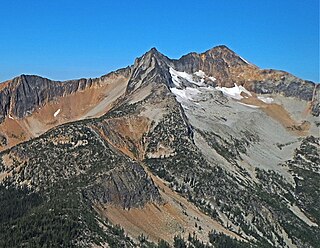
Mount Lago is a prominent 8,745-foot (2,665-metre) mountain summit located in the Okanogan Range of the North Cascades, in Okanogan County of Washington state. The mountain is situated on the eastern side of the Cascade crest, in the Pasayten Wilderness, on land managed by the Okanogan–Wenatchee National Forest. The nearest higher peak is Jack Mountain, 19.5 miles (31.4 km) to the west-southwest. Mount Lago is the highest summit of the Okanogan Range, and follows only Jack Mountain {9,075 ft} as the highest peak in the Pasayten Wilderness. Lago is the fourth-most prominent mountain in the Pasayten Wilderness. Precipitation runoff from the mountain drains into tributaries of the Pasayten River and Methow River. The mountain was named for Lage Wernstedt (1878–1959), a Forest Service surveyor who made numerous first ascents of the mountains he was mapping in the North Cascades. Lago, is a play on the way Americans pronounced his name. Lage, pronounced Loggy, had a son named Lago.

Wallaby Peak is a 7,995-foot (2,437-metre) mountain summit located on the boundary line of the Lake Chelan-Sawtooth Wilderness, in Okanogan County, Washington. The mountain is part of the Methow Mountains, which are a subset of the Cascade Range. Wallaby Peak is situated on Kangaroo Ridge which is approximately two miles east and within view of Washington Pass. The nearest higher peak is Big Kangaroo, 0.86 mi (1.38 km) to the north. Precipitation runoff from the peak drains into Early Winters Creek, Cedar Creek, and North Fork Twisp River, all of which are tributaries of the Methow River.
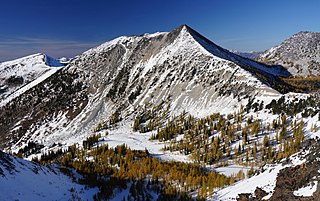
Courtney Peak is an 8,394-foot (2,558-metre) mountain summit located in the Methow Mountains which are a sub-range of the North Cascades in Washington state. Situated on Sawtooth Ridge, Courtney Peak is part of the Lake Chelan-Sawtooth Wilderness, a protected area within the Okanogan–Wenatchee National Forest. Courtney Peak ranks 80th on Washington's highest 100 peaks, and 81st on the "Bulger List". The nearest higher peak is Star Peak, 0.83 miles (1.34 km) to the southeast. Precipitation runoff on the west side of the mountain drains into nearby Lake Chelan via Fish Creek, whereas the north side of the mountain drains into Oval Creek, and the east side drains into Buttermilk Creek, both of which are tributaries of the Twisp River. The mountain's name was officially adopted in 1985 to remember James (Ray) Courtney (1920-1982), a commercial packer and lifelong resident of Stehekin. The immediate vicinity of this peak was a favorite destination for his guided outings. Ray Courtney died in an accident while leading such a pack trip with 29 hikers when the horse he was riding lost its footing and fell down a gully.

Gray Peak is an 8,086-foot (2,465-metre) mountain summit located in the Methow Mountains, a sub-range of the North Cascades in Washington state. Situated on Sawtooth Ridge, west of Oval Lakes, Gray Peak is protected by the Lake Chelan-Sawtooth Wilderness within the Okanogan–Wenatchee National Forest. The nearest higher peak is Courtney Peak, 1.07 miles (1.72 km) to the southeast. Precipitation runoff on the south side of the mountain drains into nearby Lake Chelan via Fish Creek, whereas the north side of the mountain drains into Oval Creek, which is a tributary of the Twisp River.

Finney Peak is an 8,110-foot (2,470-metre) mountain summit located West of Sawtooth Ridge(The Sawtooths), a sub-range of the North Cascades in Chelan County of Washington state. Finney Peak is situated within the Lake Chelan-Sawtooth Wilderness on land managed by the Okanogan–Wenatchee National Forest. The nearest higher peak is Star Peak, 3 miles (4.8 km) to the northeast. Precipitation runoff from the mountain drains into nearby Lake Chelan via Prince Creek and Cascade Creek.

Martin Peak is an 8,377-foot (2,553-metre) mountain summit located in the Methow Mountains, a subset of the North Cascades in Washington state. It is the seventh-highest peak in the Methow Mountains, and ranks 80th in the state of Washington. Martin Peak is set on Sawtooth Ridge, at the head of Martin Creek, on land managed by the Okanogan-Wenatchee National Forest. Other peaks of Sawtooth Ridge include Oval Peak, Star Peak, Hoodoo Peak, Courtney Peak, Switchback Peak, and Mount Bigelow, which is the nearest higher neighbor, 2.06 miles (3.32 km) to the north of Martin.

Switchback Peak is an 8,321-foot (2,536-metre) mountain summit located in the Methow Mountains, a subset of the North Cascades in Washington state. It is the eighth-highest peak in the Methow Mountains, and ranks 95th in the state of Washington. Switchback Peak is set on Sawtooth Ridge, on land managed by the Okanogan-Wenatchee National Forest. Other peaks of Sawtooth Ridge include Oval Peak, Star Peak, Hoodoo Peak, Courtney Peak, Mount Bigelow, and Martin Peak, which is the nearest higher neighbor, 0.96 miles (1.54 km) to the north.
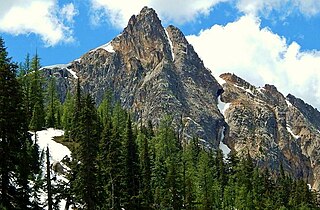
Pica Peak is a 7,565-foot (2,306-metre) summit located in the Methow Mountains, a subset of the North Cascades, on the shared border between Okanogan County and Chelan County in Washington state. Pica Peak is situated 1.7 mi (2.7 km) southeast of Washington Pass, within the Okanogan-Wenatchee National Forest. The nearest higher neighbor is Copper Benchmark, 0.58 miles (0.93 km) to the southeast, and Blue Lake Peak is set 0.93 miles (1.50 km) to the west-northwest. Although modest in prominence, relief is significant as the peak rises 2,000 feet above Early Winters Basin in only 0.5 mi (1 km). Precipitation runoff on the north side of the mountain drains to the Methow River via Early Winters Creek, whereas the south side of the mountain drains into tributaries of the Stehekin River.
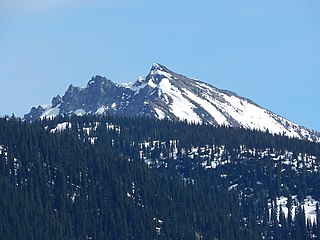
Hock Mountain is a 7,750-foot-elevation summit located in the Methow Mountains which are a subset of the North Cascades in Washington state. It is situated on the triple-shared boundary of North Cascades National Park, Lake Chelan-Sawtooth Wilderness, and Lake Chelan National Recreation Area, as well as the shared border between Chelan County and Okanogan County. Additionally, it lies one mile southwest of Twisp Mountain, and 2.24 miles (3.60 km) due south of Stiletto Peak, the nearest higher neighbor. The north face is steep, granitic rock, but the west slope is more moderate, allowing a scramble ascent. Precipitation runoff from the north and west sides of Hock drains to the Stehekin River via Bridge Creek, whereas the south and east sides of the mountain drain into the South Fork Twisp River.

Twisp Mountain is a 7,161-foot-elevation summit located in the Methow Mountains, a subset of the North Cascades in Washington state. It is situated on the shared boundary of North Cascades National Park with Lake Chelan-Sawtooth Wilderness, as well as the common border between Chelan County and Okanogan County. Additionally, it rises immediately southwest of Twisp Pass, and one mile northeast of Hock Mountain, the nearest higher neighbor. Precipitation runoff from the west side of Twisp Mountain drains to the Stehekin River via Bridge Creek, whereas the east side of the mountain drains into the South Fork Twisp River.
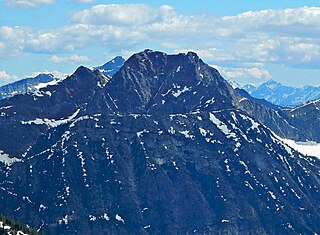
Mother Lode is a 7,905-foot-elevation (2,409-meter) mountain summit located in the North Cascades, in Okanogan County, Washington. It is situated in the Lake Chelan-Sawtooth Wilderness, on land managed by Okanogan–Wenatchee National Forest. The mountain is part of the Methow Mountains, which are a subset of the Cascade Range, and the peak is approximately two miles east of the crest of the range. Mother Lode is set approximately six miles south of Washington Pass, and the nearest higher neighbor is Gilbert Mountain, three miles to the northeast. Topographic relief is significant as the north aspect rises 3,500 feet above the South Fork Twisp River in one mile. The peak was climbed in 1983 by Rick La Belle and Glen Sterr via the north ridge, and the northeast ridge was climbed in 1985 by Carl and Gordon Skoog. Precipitation runoff from the peak drains into tributaries of Twisp River, which in turn is a tributary of the Methow River.
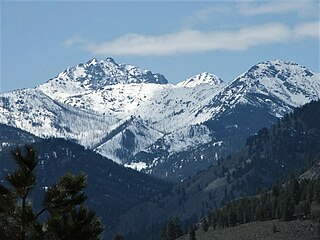
Gardner Mountain is an 8,898-foot-elevation (2,712-meter) mountain summit in Okanogan County of Washington state.
